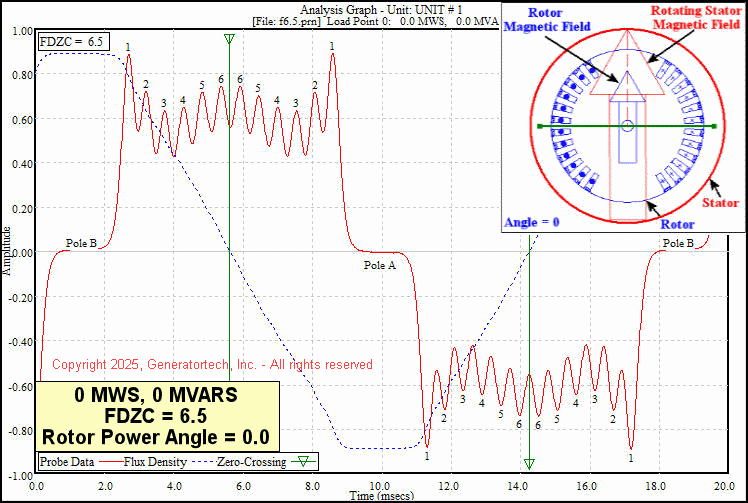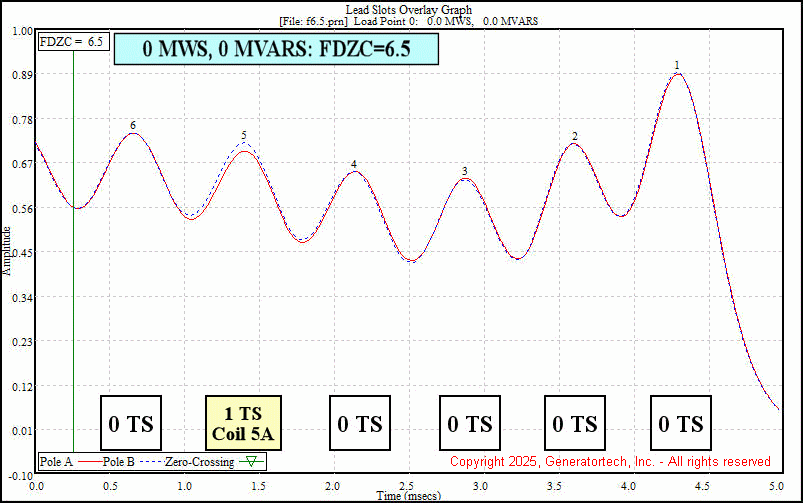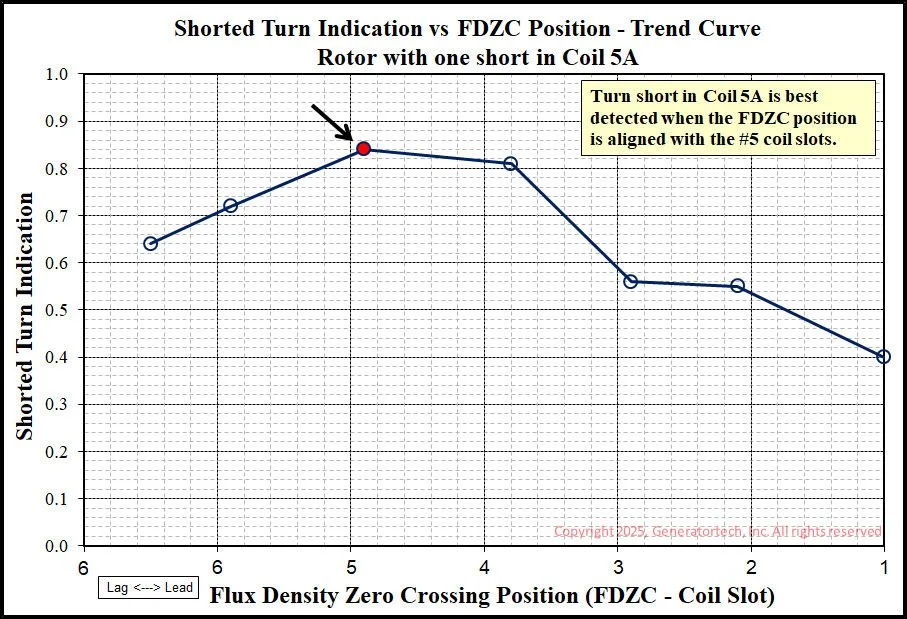Overview of Shorted Turn Theory & Flux Probe Testing
When current flows through a rotor winding, it creates a magnetic field around the rotor. As the rotor spins past a flux probe, the sensor records changes in this magnetic field. A flux probe test detects shorted turns in the rotor windings by measuring the magnetic field produced by each coil in a generator's rotor.
The magnetic field produced by a coil is proportional to the field current times the number of active turns in the coil (amp-turns or magnetomotive force [MMF]). If a turn short s present, the number of active turns in the coil is reduced and the resulting field decrease can be calculated through an analysis of the flux probe waveform.
The rotor cross-section below shows a two-pole rotor with 6 coils/pole using 18 turns in Coil 1 and 20 turns in Coils 2-6. Note that each coil has two slots, with one slot leading and the other slot lagging the pole face in terms of the rotation direction. This rotor had a single turn short in Coil 5-Pole A (Coil 5A).
The annotated Analysis Graph below shows a waveform from this same rotor recorded at 48 MWS, 0 MVARS. The raw flux probe data (red) shows numbered peaks that correspond to each coil slot displayed in the cross-section. The flux density curve (dotted blue) shows the magnetic field strength around the rotor. The flux density zero-crossing (FDZC) position is marked with a vertical green line.
The FDZC position is important because the coil that aligns with the FDZC position will have the best detection sensitivity for true turn shorts and the least sensitivity for false turn short indications (in this case, the FDZC position is closely aligned with Coil 3).
In most cases, true turn shorts in a coil are not detectable over the entire load range. True turn short indications grow larger as the FDZC moves closer to alignment with the affected coil. In order to get the best sensitivity for detecting shorted turns in all rotor coils, a series of waveforms is recorded as the load on the unit is varied. Real (MWS) and reactive (MVARS) load changes will move the FDZC position of the waveform. An ideal test set would have waveforms with FDZC positions aligned with each coil in the rotor. For a real test, waveforms are analyzed that have the closest FDZC position to each rotor coil.
False turn shorts are peak height differences that are not related to true shorts. These are normally modulation artifacts that grow larger as the FDZC position moves away from the affected coil (i.e., with increasing magnetic field). Aligning the FDZC position with a coil not only maximizes true turn short detection sensitivity, but also minimizes false turn short indications for that coil.
Since it is important to record data over a wide range of loads, flux probe testing during startups or shutdowns is ideal. The Generatortech software automatically records optimized waveforms for each rotor coil as load on the generator is changing, so the equipment can be setup before a startup or shutdown and be left to record the necessary data. The startup or shutdown can be performed as is normally done by the plant. If testing cannot be done during a startup or shutdown, then testing is done with the widest range of real power permitted. If possible, reactive load changes at minimum and maxim real loads can increase detection sensitivity in the smallest and largest rotor coils.
Rotor Cross-section - shows a two-pole rotor with 6 coils/pole and a single short in Coil 5-Pole A (Coil 5A, 20 total turns). The change in the heat produced by each coil due to that short is also displayed.
Analysis Graph - from a rotor with 6 coils/pole and a Coil 5A turn short. Labels on the graphs identify features of interest. Compare with the rotor cross-section to understand how the waveform ‘s peaks correlate with the coil slots.
The animations below show a complete test of the same rotor shown above with a short in Coil 5A. The seven waveforms were recorded during a startup that reached full load. The FDZC position moves to the right as the load increases from no-load to full-load Alignment of the FDZC with Coil 1 was achieved using negative MVARS at full load (83 MWS, - 28 MVARS), The FDZC position is determined by the Rotor Power Angle, which is the angular separation between the north pole of the rotor and the north pole of the rotating stator field. The rotor power angle changes with both input torque changes (Real Power changes) and the rotor magnetic field strength (determined by Field Current, which can be altered through Reactive Power changes. The first animation shows the Analysis Graph waveforms with their associated Rotor Power Angles.
The second animation shows the Lead Slot Overlay Graphs for the test. While the short in Coil 5A is not well detected in the higher loads when the FDZC position was far from the #5 coils, the short was easily detected at low loads. The Trend Curve below shows the calculated turn short indication for Coil 5A was maximized when the FDZC position was near alignment with the #5 coil slots. Testing at just the higher loads would miss the Coil 5A short.
Analysis Graph Animation - FDZC position (green line) moves to right toward the smaller coils (Coils 1 and 2) as real load increases. Reducing field current (negative MVARS) also moves the FDZC to the right. The FDZC position is determined by the Rotor Power Angle.
Lead Slot Overlay Graph Animation - a pole-to-pole comparison of peaks shows the Coil 5A short is only detectable at low loads (when FDZC position is close to alignment with the #5 coils). Testing at just full load would have missed this turn short.
Shorted Turn Indication Trend Curve - the indication for a true short will be optimized when the waveform’s FDZC position is closely aligned with that coil.






